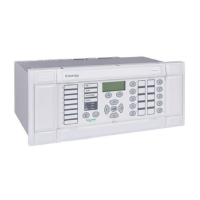Operation P54x/EN OP/La4
MiCOM P543, P544, P545 & P546
(OP) 5-159
OP
4.5.1 Circuit breaker condition monitoring features (P543/P545)
For each circuit breaker trip operation the relay records statistics as shown in the following
table taken from the relay menu. The menu cells shown are counter values only. The
Min./Max. values in this case show the range of the counter values. These cells can not be
set.
Setting
Menu text Default
Min. Max.
Step size
CB Operations
{3 pole tripping}
0 0 10000 1
Displays the total number of 3 pole trips issued by the relay.
Total A Broken
0 0
25000 n^
1
Displays the total fault current interrupted by the relay for the A phase.
Total B Broken
0 0
25000 n^
1
Displays the total fault current interrupted by the relay for the A phase.
Total C Broken
0 0
25000 n^ 1 n^
Displays the total fault current interrupted by the relay for the A phase.
CB Operate Time 0 0 0.5 s 0.001
Displays the calculated CB operating time.
Reset CB Data No Yes, No
Reset the CB condition counters.
The above counters may be reset to zero, for example, following a maintenance inspection
and overhaul. The circuit breaker condition monitoring counters will be updated every time
the relay issues a trip command. In cases where the breaker is tripped by an external
protection device it is also possible to update the CB condition monitoring. This is achieved
by allocating one of the relays opto-isolated inputs (via the programmable scheme logic) to
accept a trigger from an external device. The signal that is mapped to the opto is called
‘External Trip’.
Note: When in Commissioning test mode the CB condition monitoring
counters will not be updated.
The measurement of circuit breaker operating time, broken current and the overall CB
Monitoring logic diagram, now follow as Figure 102, Figure 103, and Figure 104.

